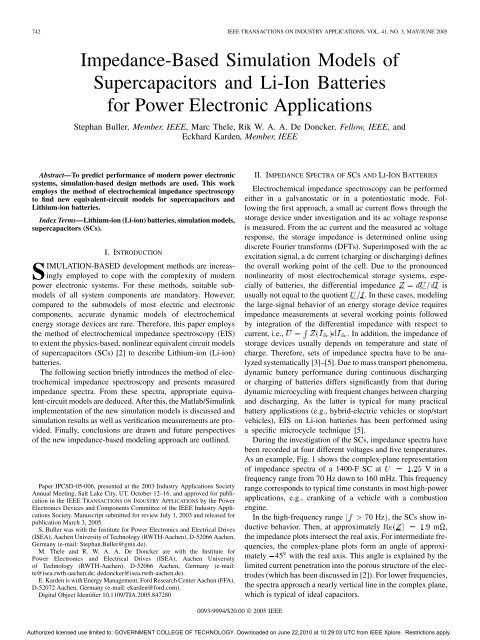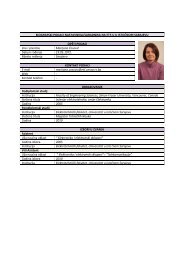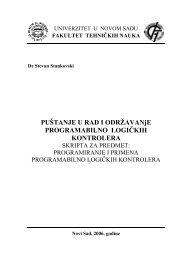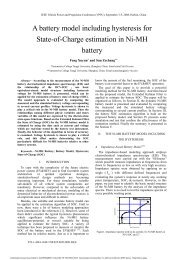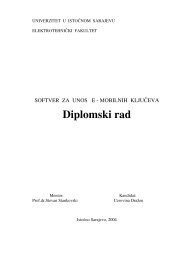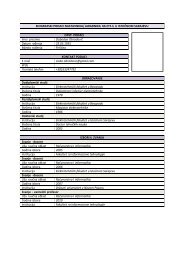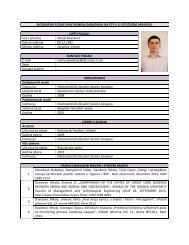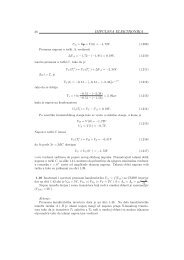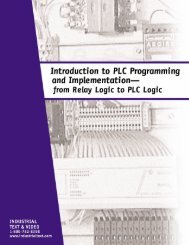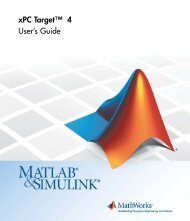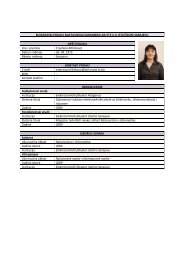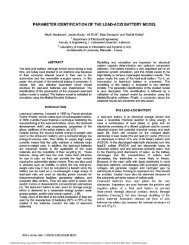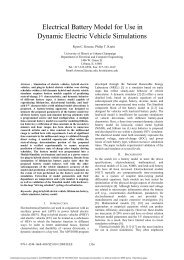Impedance-Based Simulation Models of Supercapacitors and Li-Ion ...
Impedance-Based Simulation Models of Supercapacitors and Li-Ion ...
Impedance-Based Simulation Models of Supercapacitors and Li-Ion ...
Create successful ePaper yourself
Turn your PDF publications into a flip-book with our unique Google optimized e-Paper software.
742 IEEE TRANSACTIONS ON INDUSTRY APPLICATIONS, VOL. 41, NO. 3, MAY/JUNE 2005<br />
<strong>Impedance</strong>-<strong>Based</strong> <strong>Simulation</strong> <strong>Models</strong> <strong>of</strong><br />
<strong>Supercapacitors</strong> <strong>and</strong> <strong>Li</strong>-<strong>Ion</strong> Batteries<br />
for Power Electronic Applications<br />
Stephan Buller, Member, IEEE, Marc Thele, Rik W. A. A. De Doncker, Fellow, IEEE, <strong>and</strong><br />
Eckhard Karden, Member, IEEE<br />
Abstract—To predict performance <strong>of</strong> modern power electronic<br />
systems, simulation-based design methods are used. This work<br />
employs the method <strong>of</strong> electrochemical impedance spectroscopy<br />
to find new equivalent-circuit models for supercapacitors <strong>and</strong><br />
<strong>Li</strong>thium-ion batteries.<br />
Index Terms—<strong>Li</strong>thium-ion (<strong>Li</strong>-ion) batteries, simulation models,<br />
supercapacitors (SCs).<br />
I. INTRODUCTION<br />
SIMULATION-BASED development methods are increasingly<br />
employed to cope with the complexity <strong>of</strong> modern<br />
power electronic systems. For these methods, suitable submodels<br />
<strong>of</strong> all system components are m<strong>and</strong>atory. However,<br />
compared to the submodels <strong>of</strong> most electric <strong>and</strong> electronic<br />
components, accurate dynamic models <strong>of</strong> electrochemical<br />
energy storage devices are rare. Therefore, this paper employs<br />
the method <strong>of</strong> electrochemical impedance spectroscopy (EIS)<br />
to extent the physics-based, nonlinear equivalent circuit models<br />
<strong>of</strong> supercapacitors (SCs) [2] to describe <strong>Li</strong>thium-ion (<strong>Li</strong>-ion)<br />
batteries.<br />
The following section briefly introduces the method <strong>of</strong> electrochemical<br />
impedance spectroscopy <strong>and</strong> presents measured<br />
impedance spectra. From these spectra, appropriate equivalent-circuit<br />
models are deduced. After this, the Matlab/Simulink<br />
implementation <strong>of</strong> the new simulation models is discussed <strong>and</strong><br />
simulation results as well as verification measurements are provided.<br />
Finally, conclusions are drawn <strong>and</strong> future perspectives<br />
<strong>of</strong> the new impedance-based modeling approach are outlined.<br />
Paper IPCSD-05-006, presented at the 2003 Industry Applications Society<br />
Annual Meeting, Salt Lake City, UT, October 12–16, <strong>and</strong> approved for publication<br />
in the IEEE TRANSACTIONS ON INDUSTRY APPLICATIONS by the Power<br />
Electronics Devices <strong>and</strong> Components Committee <strong>of</strong> the IEEE Industry Applications<br />
Society. Manuscript submitted for review July 1, 2003 <strong>and</strong> released for<br />
publication March 3, 2005.<br />
S. Buller was with the Institute for Power Electronics <strong>and</strong> Electrical Drives<br />
(ISEA), Aachen University <strong>of</strong> Technology (RWTH-Aachen), D-52066 Aachen,<br />
Germany (e-mail: Stephan.Buller@gmx.de).<br />
M. Thele <strong>and</strong> R. W. A. A. De Doncker are with the Institute for<br />
Power Electronics <strong>and</strong> Electrical Drives (ISEA), Aachen University<br />
<strong>of</strong> Technology (RWTH-Aachen), D-52066 Aachen, Germany (e-mail:<br />
te@isea.rwth-aachen.de; dedoncker@isea.rwth-aachen.de).<br />
E. Karden is with Energy Management, Ford Research Center Aachen (FFA),<br />
D-52072 Aachen, Germany (e-mail: ekarden@ford.com).<br />
Digital Object Identifier 10.1109/TIA.2005.847280<br />
II. IMPEDANCE SPECTRA OF SCS AND LI-ION BATTERIES<br />
Electrochemical impedance spectroscopy can be performed<br />
either in a galvanostatic or in a potentiostatic mode. Following<br />
the first approach, a small ac current flows through the<br />
storage device under investigation <strong>and</strong> its ac voltage response<br />
is measured. From the ac current <strong>and</strong> the measured ac voltage<br />
response, the storage impedance is determined online using<br />
discrete Fourier transforms (DFTs). Superimposed with the ac<br />
excitation signal, a dc current (charging or discharging) defines<br />
the overall working point <strong>of</strong> the cell. Due to the pronounced<br />
nonlinearity <strong>of</strong> most electrochemical storage systems, especially<br />
<strong>of</strong> batteries, the differential impedance<br />
is<br />
usually not equal to the quotient . In these cases, modeling<br />
the large-signal behavior <strong>of</strong> an energy storage device requires<br />
impedance measurements at several working points followed<br />
by integration <strong>of</strong> the differential impedance with respect to<br />
current, i.e.,<br />
. In addition, the impedance <strong>of</strong><br />
storage devices usually depends on temperature <strong>and</strong> state <strong>of</strong><br />
charge. Therefore, sets <strong>of</strong> impedance spectra have to be analyzed<br />
systematically [3]–[5]. Due to mass transport phenomena,<br />
dynamic battery performance during continuous discharging<br />
or charging <strong>of</strong> batteries differs significantly from that during<br />
dynamic microcycling with frequent changes between charging<br />
<strong>and</strong> discharging. As the latter is typical for many practical<br />
battery applications (e.g., hybrid-electric vehicles or stop/start<br />
vehicles), EIS on <strong>Li</strong>-ion batteries has been performed using<br />
a specific microcycle technique [5].<br />
During the investigation <strong>of</strong> the SCs, impedance spectra have<br />
been recorded at four different voltages <strong>and</strong> five temperatures.<br />
As an example, Fig. 1 shows the complex-plane representation<br />
<strong>of</strong> impedance spectra <strong>of</strong> a 1400-F SC at<br />
Vina<br />
frequency range from 70 Hz down to 160 mHz. This frequency<br />
range corresponds to typical time constants in most high-power<br />
applications, e.g., cranking <strong>of</strong> a vehicle with a combustion<br />
engine.<br />
In the high-frequency range Hz , the SCs show inductive<br />
behavior. Then, at approximately m ,<br />
the impedance plots intersect the real axis. For intermediate frequencies,<br />
the complex-plane plots form an angle <strong>of</strong> approximately<br />
45 with the real axis. This angle is explained by the<br />
limited current penetration into the porous structure <strong>of</strong> the electrodes<br />
(which has been discussed in [2]). For lower frequencies,<br />
the spectra approach a nearly vertical line in the complex plane,<br />
which is typical <strong>of</strong> ideal capacitors.<br />
0093-9994/$20.00 © 2005 IEEE<br />
Authorized licensed use limited to: GOVERNMENT COLLEGE OF TECHNOLOGY. Downloaded on June 22,2010 at 10:29:03 UTC from IEEE Xplore. Restrictions apply.
BULLER et al.: IMPEDANCE-BASED SIMULATION MODELS OF SCs AND <strong>Li</strong>-ION BATTERIES 743<br />
Fig. 3.<br />
Equivalent-circuit model <strong>of</strong> the <strong>Li</strong>-ion battery.<br />
Fig. 1.<br />
Complex-plane diagram <strong>of</strong> impedance spectra <strong>of</strong> a 1400-F SC<br />
manufactured by Montena Components SA, U =1:25 V.<br />
Fig. 4. Complex-plane impedance diagram <strong>of</strong> measured <strong>and</strong> modeled<br />
impedance data <strong>of</strong> the <strong>Li</strong>-ion battery at # =25 C, 80% SOC, I =0A <strong>and</strong><br />
I =1A charge.<br />
III. EQUIVALENT-CIRCUIT MODELS<br />
Fig. 2. <strong>Impedance</strong> spectra <strong>of</strong> an <strong>Li</strong>-ion battery (I =0A, # =25 C).<br />
Fig. 2 shows measured impedance spectra <strong>of</strong> a <strong>Li</strong>-ion battery<br />
(Saft LM 176065, 3.6 V/5 Ah) at room temperature for different<br />
states <strong>of</strong> charge (in this case with zero dc current). <strong>Impedance</strong><br />
data have been recorded for eight frequencies per frequency<br />
decade starting at 6 kHz. For all spectra, some characteristic<br />
frequencies are given. At approximately ,<br />
the real axis intersection <strong>of</strong> the impedance spectra is observed.<br />
For lower frequencies, all spectra show two capacitive semicircles.<br />
The first semicircle is comparably small <strong>and</strong> slightly depressed,<br />
whereas the second one is larger, nearly nondepressed,<br />
<strong>and</strong> grows remarkably with decreasing state <strong>of</strong> charge. Finally,<br />
at the low-frequency end <strong>of</strong> the depicted spectra, diffusion becomes<br />
visible. The diffusion impedance shows a 45 slope,<br />
which is typical <strong>of</strong> a so-called Warburg impedance. Due to the<br />
boundary condition for diffusion <strong>of</strong> <strong>Li</strong> ions in the electrodes,<br />
the diffusion branch <strong>of</strong> the spectrum approaches a capacitor-like<br />
impedance spectrum 90 for even lower frequencies.<br />
<strong>Impedance</strong> spectra <strong>of</strong> valve-regulated lead-acid batteries<br />
(VRLA) with different superimposed dc currents have also<br />
been measured at several state <strong>of</strong> changes (SOCs) <strong>and</strong> temperatures.<br />
These results are beyond the scope <strong>of</strong> this paper but can<br />
be found in [1], <strong>and</strong> [4].<br />
The discussion <strong>of</strong> the model topology <strong>and</strong> the general modeling<br />
principle in this section concentrates on the <strong>Li</strong>-ion battery<br />
technology. In the case <strong>of</strong> SCs, excellent agreement with<br />
the measured impedance spectra was achieved using a ladder<br />
network model, consisting <strong>of</strong> the resistance <strong>of</strong> the pore electrolyte<br />
<strong>and</strong> the nonlinear double-layer capacitance <strong>of</strong> the phase<br />
boundary electrode/electrolyte. Detailed results as well as the<br />
lumped-element representation <strong>of</strong> the ladder network are reported<br />
in [1] <strong>and</strong> [2].<br />
To model the recorded impedance spectra, suitable equivalent-circuit<br />
topologies have to be defined. <strong>Based</strong> on the underlying<br />
physical processes, the equivalent circuits should allow<br />
an optimum representation <strong>of</strong> the measured spectra with a minimum<br />
set <strong>of</strong> model parameters. In a second step, the model<br />
parameters have to be calculated. To minimize the deviations<br />
between modeled data <strong>and</strong> measured spectra, a least-square<br />
fitting algorithm is employed.<br />
In Fig. 3, the electric equivalent circuit <strong>of</strong> an <strong>Li</strong>-ion battery<br />
is depicted. This circuit consists <strong>of</strong> an inductance , an ohmic<br />
resistance , a so-called element representing a depressed<br />
semicircle in the complex-plane [1], [3], a nonlinear<br />
RC circuit ( <strong>and</strong> ) as well as <strong>of</strong> a Warburg impedance<br />
. Using the depicted model topology, the observed ac behavior<br />
<strong>of</strong> an <strong>Li</strong>-ion battery can be described accurately. The<br />
following adaptation <strong>of</strong> the model to the measured impedance<br />
spectra shows that, despite several simplifications, all relevant<br />
processes including porosity, charge transfer <strong>and</strong> diffusion are<br />
modeled with sufficient precision.<br />
Fig. 4 compares measured <strong>and</strong> calculated impedance data <strong>of</strong><br />
the <strong>Li</strong>-ion battery at 25 C <strong>and</strong> 80% SOC. For all frequencies<br />
<strong>and</strong> both depicted dc currents, the corresponding curves show<br />
nearly perfect agreement.<br />
Authorized licensed use limited to: GOVERNMENT COLLEGE OF TECHNOLOGY. Downloaded on June 22,2010 at 10:29:03 UTC from IEEE Xplore. Restrictions apply.
744 IEEE TRANSACTIONS ON INDUSTRY APPLICATIONS, VOL. 41, NO. 3, MAY/JUNE 2005<br />
Fig. 5. Nonlinearity <strong>of</strong> the resistance R (# =25 C, 50% SOC).<br />
Fig. 6.<br />
Open-circuit voltage as a function <strong>of</strong> the state <strong>of</strong> charge (<strong>Li</strong>-ion).<br />
Obviously, the diameter <strong>of</strong> the low-frequency semicircle, i.e.,<br />
parameter , strongly depends on the dc current that is superimposed<br />
during the impedance measurement. The nonlinearity<br />
<strong>of</strong> with dc current is depicted in Fig. 5. Apart from<br />
the data points, which have been determined from the measured<br />
impedance spectra, Fig. 5 also shows a calculated curve which<br />
models the current dependency <strong>of</strong> .<br />
The relation between the dc current <strong>and</strong> the corresponding<br />
overvoltage at the impedance element can be described<br />
by a Boltzmann-type equation. In electrochemistry, this type <strong>of</strong><br />
equation is known as Butler–Volmer equation (1). The constants<br />
are the exchange current , the number <strong>of</strong> transferred elementary<br />
charges , the symmetry coefficient , <strong>and</strong> the<br />
thermal voltage ( mV if K).<br />
The nonlinear charge transfer resistance<br />
as<br />
(1)<br />
can be calculated<br />
Equation (2) can be solved analytically for the special cases<br />
, (irreversible reactions), <strong>and</strong> (symmetric<br />
kinetics). In all other cases, numeric calculation is required.<br />
Therefore, to determine the Butler–Volmer parameters<br />
, , <strong>and</strong> from the data points in Fig. 5, a second fitting algorithm<br />
is employed.<br />
The best approximation <strong>of</strong> the data points is obtained for<br />
A, , <strong>and</strong> . For classic redox reactions,<br />
represents the change in oxidation number <strong>of</strong> the reaction<br />
ions. Hence, integer values are expected. However, for<br />
the <strong>Li</strong>-ion battery, a noninteger value for was found to be<br />
best. This result might be explained by the specific nature <strong>of</strong> the<br />
<strong>Li</strong> intercalation reaction or might be due to the simplifications<br />
that are necessary to allow a parameterization <strong>of</strong> the simulation<br />
model without reference electrode measurements. An electrochemical<br />
investigation <strong>of</strong> this finding is not required for the further<br />
development <strong>of</strong> the dynamic battery model <strong>and</strong> is therefore<br />
considered beyond the scope <strong>of</strong> this work.<br />
Finally, Fig. 6 shows the open-circuit battery voltage as<br />
function <strong>of</strong> the state <strong>of</strong> charge. The <strong>Li</strong>-ion battery was partly<br />
(2)<br />
Fig. 7.<br />
Approximation <strong>of</strong> a ZARC element by RC circuits.<br />
discharged <strong>and</strong> the open-circuit voltage was measured after a<br />
minimum rest period <strong>of</strong> five hours. The curve in Fig. 6 can be<br />
stored into a lookup table.<br />
IV. MODEL IMPLEMENTATION<br />
So far, the dynamic behavior <strong>of</strong> the modeled energy storage<br />
devices is still described in the frequency domain. The time-domain<br />
behavior <strong>of</strong> the equivalent-circuit model can be calculated<br />
by solving a set <strong>of</strong> ordinary differential equations. For this calculation,<br />
simulation tools like Matlab/Simulink can be employed.<br />
However, not all complex impedance elements (e.g., ZARC elements<br />
<strong>and</strong> Warburg impedances) can directly be implemented<br />
in a common circuit simulation tool. For these elements, appropriate<br />
approximations by means <strong>of</strong> RC circuits or RC ladder network<br />
topologies have to be found first [1].<br />
As an example, the basic idea for the representation <strong>of</strong> a<br />
ZARC element, employed to model a depressed, capacitive<br />
semicircle in the complex-plane diagram, is depicted in Fig. 7.<br />
The approximation is based on a series connection <strong>of</strong> nonlinear<br />
RC circuits. All RC circuits are fully determined by the parameters<br />
<strong>of</strong> the ZARC element. Thus, the number <strong>of</strong> experimental<br />
parameters remains constant. With an increasing number <strong>of</strong><br />
RC circuits, the approximation <strong>of</strong> the ZARC elements becomes<br />
more <strong>and</strong> more precise. However, the calculating time increases.<br />
Thus, an appropriate compromise between simulation<br />
accuracy <strong>and</strong> computation effort has to be found. This question<br />
is thoroughly discussed in [1].<br />
The specific model parameters which are needed for the simulation<br />
<strong>of</strong> a certain battery are stored in a separate file. To allow<br />
a linear adaptation <strong>of</strong> a parameterized battery model to differently<br />
sized batteries <strong>of</strong> the same technology, all parameters are<br />
defined with respect to the battery’s nominal current <strong>and</strong> the<br />
number <strong>of</strong> battery cells connected in series. Furthermore, due to<br />
the nonlinearity <strong>of</strong> some impedance elements, the original battery<br />
current in the simulation model is replaced by the relative<br />
current .<br />
Authorized licensed use limited to: GOVERNMENT COLLEGE OF TECHNOLOGY. Downloaded on June 22,2010 at 10:29:03 UTC from IEEE Xplore. Restrictions apply.
BULLER et al.: IMPEDANCE-BASED SIMULATION MODELS OF SCs AND <strong>Li</strong>-ION BATTERIES 745<br />
Fig. 8.<br />
Current pr<strong>of</strong>ile for the verification <strong>of</strong> the SC model.<br />
Fig. 10. Comparison <strong>of</strong> the measured voltage response <strong>and</strong> the data obtained<br />
from different simulation models.<br />
TABLE I<br />
COMPARISON OF MEASURED AND SIMULATED EFFICIENCY DATA.WORKING<br />
POINT: 1.5 V, ROOM TEMPERATURE, CYCLE DEPTH 615% Q<br />
Fig. 9.<br />
Measured <strong>and</strong> simulated voltage response to the current pr<strong>of</strong>ile.<br />
V. VERIFICATION AND APPLICATION OF THE MODELS<br />
As a final step, the results <strong>of</strong> the simulation models are compared<br />
with measured data in the time domain. Both, the SC<br />
model as well as the model <strong>of</strong> the <strong>Li</strong>-ion battery have been verified<br />
in detail [1]. In this section, some examples <strong>of</strong> these verification<br />
measurements are given.<br />
For the verification <strong>of</strong> the SC model, the current pr<strong>of</strong>ile depicted<br />
in Fig. 8 has been employed [2]. The imposed charging<br />
<strong>and</strong> discharging pulses model a highly dynamic load at the beginning<br />
as well as deeper charging <strong>and</strong> discharging periods at<br />
the end <strong>of</strong> the evaluation. The corresponding voltage curves are<br />
depicted in Fig. 9. The measured <strong>and</strong> the calculated data show<br />
excellent agreement.<br />
The influence <strong>of</strong> the porous structure <strong>of</strong> the SC electrodes<br />
can be illustrated by means <strong>of</strong> a comparison <strong>of</strong> the full simulation<br />
model with the voltage response <strong>of</strong> the simplified model<br />
which only consists <strong>of</strong> a series connection <strong>of</strong> the ohmic resistance<br />
<strong>and</strong> the capacitance <strong>of</strong> the SC. For this comparison,<br />
Fig. 10 provides an enlarged view <strong>of</strong> the first current pulses <strong>of</strong><br />
the verification pr<strong>of</strong>ile. Once more, the excellent agreement <strong>of</strong><br />
the measured <strong>and</strong> simulated voltage data becomes obvious. In<br />
addition, remarkable deviations due to the neglect <strong>of</strong> porosity<br />
are observed for the simplified model. For low frequencies, i.e.,<br />
for comparably long relaxation times, these deviations could be<br />
overcome by replacing the ohmic resistance by the larger dc<br />
resistance with being the resistance <strong>of</strong> the<br />
electrolyte in the pores <strong>of</strong> the electrodes [2]. In this case however,<br />
the fast voltage transients would not be well represented<br />
anymore.<br />
One advantage <strong>of</strong> SCs used as energy storage devices is their<br />
good energy efficiency. This efficiency is also influenced by<br />
the porous structure <strong>of</strong> the electrodes which means that the increasing<br />
real part <strong>of</strong> the impedance with decreasing frequency<br />
has to be taken into account.<br />
To compare measured <strong>and</strong> simulated efficiency data, an SC<br />
is partly charged <strong>and</strong> discharged with constant dc currents <strong>of</strong><br />
various amplitudes. The cycle depth is chosen to be 540 A s<br />
which corresponds approximately to . For each current<br />
amplitude, the charge/discharge cycle is repeated ten times<br />
but only the last five cycles, which start <strong>and</strong> finish at the same<br />
internal conditions (quasi-stationary), are used for the efficiency<br />
calculation. In a second step, the same current pr<strong>of</strong>ile is simulated<br />
by means <strong>of</strong> the newly developed capacitor model. Measured<br />
<strong>and</strong> simulated efficiency data are compared in Table I.<br />
Again, very good agreement is observed.<br />
Next, a simulation example <strong>of</strong> the <strong>Li</strong>-ion battery model is<br />
presented. For the model verification, the dynamic discharge<br />
current pr<strong>of</strong>ile depicted in Fig. 11 has been selected. The<br />
comparison <strong>of</strong> the simulated <strong>and</strong> the measured voltage response<br />
to this current pr<strong>of</strong>ile at a state <strong>of</strong> charge <strong>of</strong> 77.5% <strong>and</strong><br />
room temperature is shown in Fig. 12. Excellent agreement<br />
<strong>of</strong> the measured <strong>and</strong> the simulated voltage curves is found.<br />
The outst<strong>and</strong>ing accuracy <strong>of</strong> the simulation model is due to<br />
the exact representation <strong>of</strong> the complex battery impedance<br />
including all important nonlinearities.<br />
An important precondition for the high quality <strong>of</strong> the simulation<br />
results is the nearly perfect reproducibility <strong>of</strong> the battery<br />
Authorized licensed use limited to: GOVERNMENT COLLEGE OF TECHNOLOGY. Downloaded on June 22,2010 at 10:29:03 UTC from IEEE Xplore. Restrictions apply.
746 IEEE TRANSACTIONS ON INDUSTRY APPLICATIONS, VOL. 41, NO. 3, MAY/JUNE 2005<br />
Fig. 11.<br />
Current pr<strong>of</strong>ile for the verification <strong>of</strong> the <strong>Li</strong>-ion battery model.<br />
storage technologies, e.g., NiMH batteries or even fuel-cell<br />
stacks in the future. This versatility will allow the combined<br />
simulation <strong>of</strong> different energy storage devices for the evaluation<br />
<strong>of</strong> new storage-hybridization concepts. Furthermore, by means<br />
<strong>of</strong> additional submodels, e.g., describing mass transport in<br />
VRLA batteries, the validity range <strong>of</strong> the existing models can<br />
be further enlarged. By this, the simulation <strong>of</strong> long-lasting<br />
constant-current charging or discharging periods will become<br />
possible.<br />
Another interesting future application <strong>of</strong> the impedancebased<br />
simulation models is a detailed thermal battery design.<br />
All mechanisms <strong>of</strong> heat generation <strong>of</strong> SCs or batteries can be<br />
precisely represented. Combined with the mechanisms <strong>of</strong> heat<br />
transport <strong>and</strong> dissipation, the thermal behavior <strong>of</strong> batteries can<br />
be simulated. Consequently, the influence <strong>of</strong> different future<br />
cooling concepts, for example, on life-cycle costs, could be<br />
evaluated.<br />
ACKNOWLEDGMENT<br />
The authors are grateful to the Ford Research Center Aachen<br />
(FFA), especially to Dr. D. Kok <strong>and</strong> Dr. L. Gaedt for supporting<br />
this research project.<br />
Fig. 12. Measured <strong>and</strong> simulated voltage response <strong>of</strong> the <strong>Li</strong>-ion battery (77.5%<br />
SOC, 25 C).<br />
behavior during operation as well as the lack <strong>of</strong> parasitic reactions.<br />
From this point <strong>of</strong> view, <strong>Li</strong>-ion batteries are especially<br />
suited for any kind <strong>of</strong> model-based description. Compared to<br />
<strong>Li</strong>-ion batteries, the simulation <strong>of</strong> lead acid batteries turns out<br />
much more difficult. Nevertheless, the described simulation<br />
approach could also be successfully adapted to this battery<br />
technology [1], [4].<br />
VI. CONCLUSION AND FUTURE PERSPECTIVES<br />
This paper has shown that nonlinear, lumped-element equivalent-circuit<br />
models meet the accuracy requirements for simulation<br />
models <strong>of</strong> energy storage devices. To demonstrate the<br />
power <strong>of</strong> this modeling concept, <strong>Li</strong>-ion batteries <strong>and</strong> SCs were<br />
selected.<br />
For the determination <strong>of</strong> suitable equivalent-circuit topologies<br />
as well as for the parameterization <strong>of</strong> these models, the<br />
method <strong>of</strong> EIS was employed. After the implementation <strong>of</strong> the<br />
models, the simulation results were compared to test-bench<br />
data. Excellent agreement <strong>of</strong> simulated <strong>and</strong> measured voltage<br />
data was found.<br />
Due to the versatility the impedance-based modeling approach,<br />
the described concept can also be employed for other<br />
REFERENCES<br />
[1] S. Buller, “<strong>Impedance</strong>-based simulation models for energy storage devices<br />
in advanced automotive power systems,” Ph.D. dissertation, ISEA,<br />
RWTH Aachen, Aachen, Germany, 2003.<br />
[2] S. Buller, E. Karden, D. Kok, <strong>and</strong> R. W. De Doncker, “Modeling the<br />
dynamic behavior <strong>of</strong> supercapacitors using impedance-spectroskopy,”<br />
IEEE Trans. Ind. Appl., vol. 38, no. 6, pp. 1622–1626, Nov./Dec. 2002.<br />
[3] E. Karden, “Using low-frequency impedance spectroscopy for characterization,<br />
monitoring, <strong>and</strong> modeling <strong>of</strong> industrial batteries,” Ph.D. dissertation,<br />
ISEA, RWTH Aachen, Aachen, Germany, 2001.<br />
[4] S. Buller, M. Thele, E. Karden, <strong>and</strong> R. W. De Doncker, “<strong>Impedance</strong>based<br />
nonlinear dynamic battery modeling for automotive applications,”<br />
J. Power Sources, vol. 113, pp. 422–430, 2003.<br />
[5] E. Karden, S. Buller, <strong>and</strong> R. W. De Doncker, “A method for measurement<br />
<strong>and</strong> interpretation <strong>of</strong> impedance spectra for industrial batteries,” J.<br />
Power Sources, vol. 85, pp. 72–78, 2000.<br />
Stephan Buller (M’97) received the Ph.D. degree<br />
from the Institute for Power Electronics <strong>and</strong><br />
Electrical Drives (ISEA), Aachen University <strong>of</strong><br />
Technology (RWTH-Aachen), Aachen, Germany, in<br />
2002.<br />
He joined ISEA in 1997, spending five years as a<br />
Research Associate. From 2002 until 2004, he was<br />
a Chief Engineer at ISEA. His research activities<br />
were mainly in the area <strong>of</strong> batteries <strong>and</strong> other energy<br />
storage systems. In January 2005, he joined an<br />
international consulting company.<br />
Marc Thele received the Diploma in Electrical<br />
Engineering from the Institute for Power Electronics<br />
<strong>and</strong> Electrical Drives (ISEA), Aachen University <strong>of</strong><br />
Technology (RWTH-Aachen), Aachen, Germany, in<br />
2002.<br />
In June 2002, he joined ISEA as a Research Associate.<br />
His research activities are in the area <strong>of</strong> battery<br />
simulation models <strong>of</strong> different technologies.<br />
Authorized licensed use limited to: GOVERNMENT COLLEGE OF TECHNOLOGY. Downloaded on June 22,2010 at 10:29:03 UTC from IEEE Xplore. Restrictions apply.
BULLER et al.: IMPEDANCE-BASED SIMULATION MODELS OF SCs AND <strong>Li</strong>-ION BATTERIES 747<br />
Rik W. A. A. De Doncker (M’87–SM’99–F’01)<br />
received the Doctor <strong>of</strong> Electrical Engineering degree<br />
from the Katholieke Universiteit Leuven, Leuven,<br />
Belgium, in 1986.<br />
During 1987, he was appointed as a Visiting<br />
Associate Pr<strong>of</strong>essor at the University <strong>of</strong> Wisconsin,<br />
Madison. In December 1988, he joined the General<br />
Electric Company Corporate R&D Center, Schenectady,<br />
NY. In 1994, he joined Silicon Power<br />
Corporation as Vice President. In October 1996,<br />
he became a Pr<strong>of</strong>essor at Aachen University <strong>of</strong><br />
Technology (RWTH-Aachen), Aachen, Germany, <strong>and</strong> Head <strong>of</strong> the Institute for<br />
Power Electronics <strong>and</strong> Electrical Drives (ISEA).<br />
Eckhard Karden (M’00) received the Ph.D.<br />
degree from Aachen University <strong>of</strong> Technology<br />
(RWTH-Aachen), Aachen, Germany.<br />
He is a Research Engineer for storage systems in<br />
the Energy Management Group <strong>of</strong> the Ford Research<br />
Center Aachen (FFA), Aachen, Germany. Before he<br />
joined Ford in 2002, he was Chief Engineer at the<br />
Institute for Power Electronics <strong>and</strong> Electrical Drives<br />
(ISEA), RWTH-Aachen.<br />
Authorized licensed use limited to: GOVERNMENT COLLEGE OF TECHNOLOGY. Downloaded on June 22,2010 at 10:29:03 UTC from IEEE Xplore. Restrictions apply.


